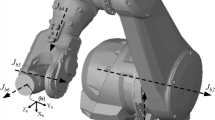Abstract
A method of robot end-effector pose accuracy improvement using joint error mutual compensation is presented. The developed method allows locating special robot configurations with the highest robot end-effector pose accuracy using joint error maximum mutual compensation. The computer simulation and experimental results confirmed the theory. The method provides the basis for an industrial application of joint error mutual compensation in the conventional robotic manipulators and allows improving robotic manipulator end-effector pose accuracy up to 2 times. The practical areas and typical robotic systems, where the developed framework of joint error mutual compensation could be applied, were presented.
Similar content being viewed by others
References
Dimov, H., Dobrinov, V., and Boiadjiev, T.: 1997, Experimental investigation of pose repeatability of manipulating robots, Probab. Engrg. Cybernet. Robotics 6, 106-111.
Dubois, D. and Resconi, G.: 1995, Advanced Research in Incursion Theory Applied to Ecology, Physics and Engineering, Ass. Des Engineers UL, Liège, Belgium.
Hrman, M., Kunica, Z., and Vranjes, B.: 1999, Positions of parts with vertical assembly paths at automatic assembly system planning, in: Intelligent Manufacturing and Automation: Proc. of Internat. Symp. DAAAM International, Vienna, Austria, pp. 199-200.
ISO 9283: 1998, Manipulating industrial robots - Performance criteria and related test methods, IOS, Zurich, Switzerland.
Kieffer, J., Cahill, A., and James, M.: 1997, Robust and accurate time-optimal path tracking control for robot manipulator, IEEE Trans. Robotics Automat. 6, 880-890.
Sergeev, V. I. and Pravotorova, E. A.: 1998, Actual questions of accuracy and parametric reliability of machines, Problems Machine-building Reliability Mach. 5, 31-41.
Smolnikov, B. A.: 1990, Problems of Mechanics and Optimization of Robots, Science, Moscow.
Veryha, Y. B. and Kourtch, L. V.: 2000, Increasing accuracy of assembly operations using industrial robots, J. Automat. Modern Technol. 7, 8-11.
Veryha, Y., Verigo, B., Kourtch, L., and Murashko V.: 2000, Method and system for robot end effector path correction using 3-D ultrasound sensors, in: Proc. of IEEE 3rd World Congress on Intelligent Control and Automation, Hefei, China, pp. 256-259.
Yurkevich, V. V.: 2000, Forecasting of accuracy of details manufacturing, J. Techniques Machine-Building 4, 46-53.
Author information
Authors and Affiliations
Rights and permissions
About this article
Cite this article
Veryha, Y., Kurek, J. Application of Joint Error Mutual Compensation for Robot End-effector Pose Accuracy Improvement. Journal of Intelligent and Robotic Systems 36, 315–329 (2003). https://doi.org/10.1023/A:1023048802627
Issue Date:
DOI: https://doi.org/10.1023/A:1023048802627




